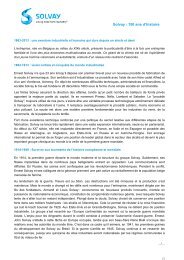solvay_live243_p02a04 somEdito
solvay_live243_p02a04 somEdito
solvay_live243_p02a04 somEdito
Create successful ePaper yourself
Turn your PDF publications into a flip-book with our unique Google optimized e-Paper software.
Dossier<br />
102496<br />
46<br />
SolvayInnovationTrophy2006<br />
SILANE: A COMPETITIVE ALTERNATIVE TO HIGH-<br />
PRESSURE STEAM CROSSLINKING TECHNOLOGY<br />
KNOW-HOW KEEPING<br />
THE COMPETITION AT BAY<br />
The cable market demands high levels<br />
of productivity yet low energy and<br />
investment costs. This project sets out to<br />
study and produce new families of material<br />
based on composite polymers to be used as<br />
insulator and sheathing for electrical cables<br />
(certain grades of which must resist fire,<br />
without recourse to halogens, nitrogen<br />
or phosphorus). But the main objective was<br />
to achieve performances only made possible<br />
by high-pressure steam drying reticulation<br />
(vulcanization) technology: softness and<br />
flexibility, elastic recover, resistance to fluids<br />
and to temperature.<br />
By studying the new polymer systems and<br />
production technologies using the Sioplassilane<br />
crosslinking technology, these<br />
properties are now available for products<br />
obtained from the classical thermoplastic<br />
extrusion lines, with a string of side benefits :<br />
low cost energy and maintenance, low<br />
investment cost for the extrusion,<br />
productivity multiplied by four, high degree<br />
of flexibility of production and waste<br />
reduction. The project, which got off the<br />
ground in 2004, has already spawned a new<br />
generation of products that are used in a<br />
number of special applications and that are<br />
quickly developing in terms of sales volumes.<br />
For the time being, no other manufacturer<br />
is selling these compounds, as our<br />
technological know-how is the best barrier<br />
to competition and an excellent way to gain<br />
customers’ loyalty.<br />
> Antonello Casale; Caterina Bocchia.<br />
> SBU SPECIALTY POLYMERS<br />
104040<br />
DYDROGESTERONE NEW PROCESS<br />
PURITY AND PERFORMANCE<br />
INCREASED<br />
Dydrogesterone is produced using<br />
“proketal”, with “retroketal”<br />
as an intermediary product. The new process,<br />
which follows the same sequence,<br />
has introduced additional “retroketal”<br />
crystallisation stages, making it much more<br />
pure. The yield of the last stage, during<br />
which the “retroketal” is transformed<br />
into dydrogesterone, has been substantially<br />
improved. Designed by Solvay<br />
Pharmaceuticals, the new unit, built<br />
in cooperation with Jacobs Engineering,<br />
was started up in two successive phases,<br />
during the 3rd and 4th quarters of 2004.<br />
It offers the following advantages:<br />
• reduction in the costs of the materials<br />
• the pooling on single line of the hygiene<br />
and environmental aspects and compliance<br />
with the GMP regulations.<br />
To sum up, Solvay Pharmaceuticals is very<br />
proud to present this new installation,<br />
internally, but also to external clients, such<br />
as pharmacists.<br />
> Ron Henneman; Fons Jacobs;<br />
Evert-Jan Jansen Schoonhoven.<br />
> PHARMACEUTICALS SECTOR<br />
104293<br />
CHECKING THE LOW IODINE DIET<br />
OF THE ELECTROLYSIS MEMBRANES<br />
OZONE TO THE<br />
MEMBRANES RESCUE<br />
The Group’s electrolytic plants<br />
are switching from mercury technology<br />
to membrane technology. In some cases,<br />
the brine that is electrolysed contains iodine<br />
as an impurity, which accumulates on the<br />
membranes and affects their efficiency.<br />
This iodine needs to be eliminated in an<br />
intermediary stage. The challenge consisted<br />
of internally developing a method for<br />
analysing the residual iodine, on the line,<br />
as no commercial solution existed. The new<br />
process that has been developed uses ozone<br />
to quantitatively transform the iodine into<br />
iodate, which is in turn analysed by<br />
spectrophotometer: a continuous analyser<br />
was developed for this method.<br />
After validation, the new system will, first of<br />
all, be installed in Rosignano (Italy). It may<br />
then be transposed to the electrolytic plants<br />
of the Group that run on salt containing<br />
iodine as an impurity.<br />
> Koen Vermeiren; Neil Breton;<br />
Davide Mantione; Alessandra Pastacaldi.<br />
> CC ANALYTICAL TECHNOLOGIES


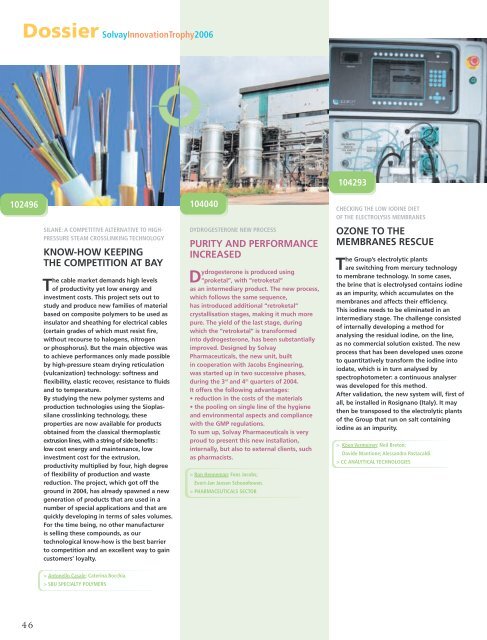

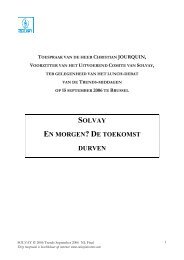
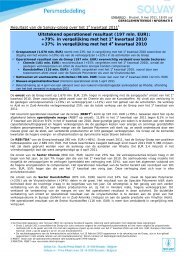

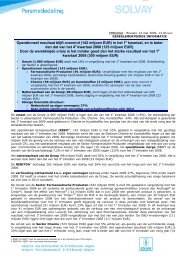
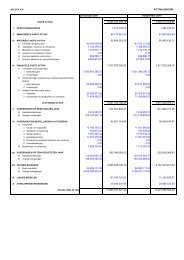


![PROC.1 [LETTRE] - Solvay](https://img.yumpu.com/16585746/1/184x260/proc1-lettre-solvay.jpg?quality=85)
